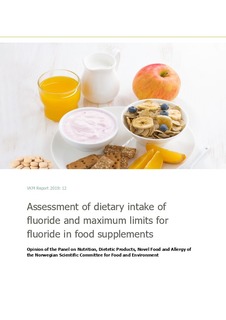| dc.description.abstract | The Norwegian Scientific Committee for Food and Environment (Vitenskapskomiteen for mat og miljø, VKM) has, at the request of the Norwegian Food Safety Authority (Mattilsynet, NFSA), evaluated the intake of fluoride in the diet, together with intake of fluoride from dental hygiene and caries prevention products. VKM has also evaluated suggested maximum limits for fluoride in food supplements at 0.5, 1, 5 and 7 mg/day in relation to established tolerable upper intake levels (ULs). The former maximum limit for fluoride of 0.5 mg/day in food supplements was repealed 30 May 2017. Fluorine is a gaseous halogen which occurs naturally only in anionic form as fluoride (F- ). Fluorides are ubiquitous in air, water and the lithosphere. Fluoride is found naturally in all water sources. The highest levels are found in groundwater. Surface water usually has lower concentrations of fluoride than groundwater, most often under 0.5 mg/L. Major dietary fluoride sources are water and tea. An important non-dietary source is dental hygiene products such as toothpaste and tablets for caries prevention. There is no fluoridation of drinking water or salt in Norway. Fluoride is not an essential nutrient. Caries is not a fluoride deficiency disease. However, because of the beneficial effects for caries prevention, an adequate intake (AI) of 0.05 mg per kg body weight per day has been set for fluoride by the European Food Safety Authority (EFSA). Readily soluble fluorides (sodium- and potassium fluoride) are rapidly and almost completely absorbed by passive diffusion in the stomach and the small intestine. Absorption is influenced by acidity and concomitant food intake. Absorbed fluoride is rapidly distributed in blood plasma, but is retained only in calcified tissues, that are bones and teeth. Consequently, 99% of the total fluoride content of the body is found in bone and teeth. Absorbed fluoride which is not deposited in calcified tissues is excreted almost exclusively via the kidneys. Whereas skeletal bone and dentine accumulate fluoride throughout life, enamel of teeth incorporate fluoride only at the time of tooth formation. Fluoride substitutes for hydroxyl groups in the apatite, increasing the resistance to caries. In permanent teeth enamel maturation is completed at the age of seven to eight years, except in the third molars. Posteruptive fluoride uptake by enamel occurs only in the outer layer and depends on local oral fluoride levels. A linear relationship between fluoride exposure and caries resistance has been demonstrated. Over the years, the view has shifted from systemic fluoride being most effective for caries prevention to local oral exposure being most important. Acute toxic effects may be provoked by fluoride, and deaths have been reported after intake of very large doses from fluoride tablets. The main adverse outcomes from intake of excess doses of fluoride over time, are enamel fluorosis in children up to eight years of age, and bone fluorosis in older children and adults. Dental fluorosis causing mottled teeth is largely a cosmetic effect, whereas bone fluorosis causes stiff joints and a greater tendency to fractures. Tolerable upper intake levels (UL) for fluoride have been set by the American Institute of Medicine (IOM) and by the European Food Safety Authority (EFSA). In this report, we relate estimated fluoride intakes to the upper level set by EFSA. Intakes of the main dietary fluoride sources, water and tea, in different age groups were obtained from Norwegian dietary surveys. High fluoride intakes were estimated by applying the 95 percentile of fluoride concentrations in water obtained from 2001 fluoride analyses from Norwegian waterworks in the period between 2010 and 2018 and in tea obtained from a Polish study to the daily volume consumed. Fluoride intakes from recommended use of dental hygiene and caries prevention products were then added, plus a small fixed value for undescribed sources. The estimated 95 percentile fluoride exposure calculated this way was compared to the upper level, and scenarios with additional fluoride supplementation of 0.5, 1, 5 or 7 mg/day were developed. The estimated 95-percentile of fluoride exposure from water, tea and dental hygiene products alone (before fluoride from the suggested food supplement doses at 0.5, 1, and 7 mg/day were added) was found to exceed the upper level for 2-year old children and for adults. VKM concludes that all the suggested food supplement doses considered will cause the tolerable upper intake level to be exceeded in all age groups, except for the supplement doses of 0.5 in 9- and 13-year olds and 1 mg/day in 9 year olds. VKM emphasises that the current assessment of maximum limits for fluoride in food supplements is merely based on published reports concerning upper levels from the IOM (USA, 2001), Scientific Committee on Food (EU, 2003), Expert Group on Vitamins and Minerals (UK, 2003) and Nordic Nutrition Recommendations (Nordic Countries, 2012). VKM has not conducted any review of the literature for the current opinion, as this was outside the scope of the terms of reference from the NFSA. | nb_NO |
